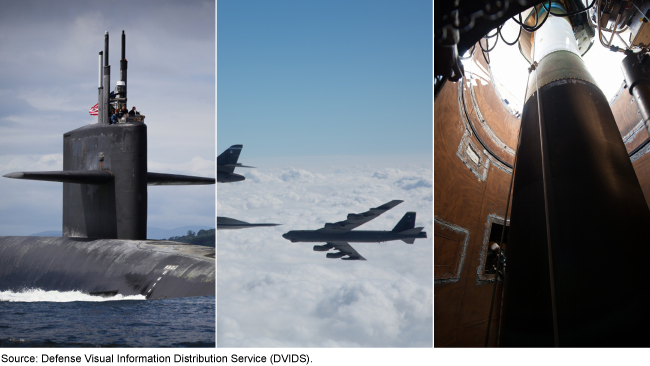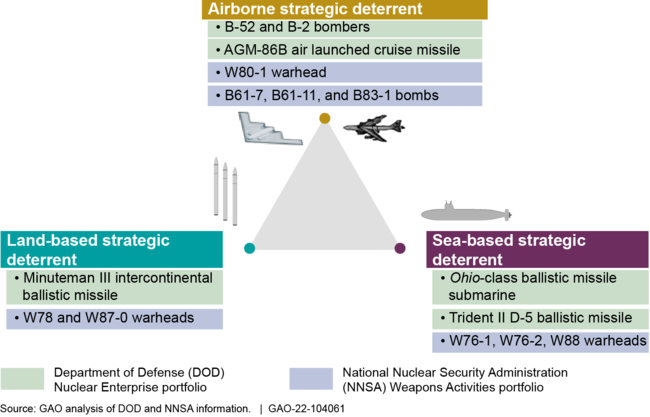Nuclear Enterprise: DOD and NNSA Could Further Enhance How They Manage Risk and Prioritize Efforts
Fast Facts
The Department of Defense is committed to modernizing the U.S. nuclear enterprise. This includes weapons and the infrastructure to build them (the Department of Energy's responsibility), as well as the aircraft, missiles, and other platforms for delivering them (DOD's responsibility). DOD and DOE could further enhance their nuclear work in these areas:
- DOD and DOE should jointly identify and respond to nuclear enterprise risks
- DOD needs criteria for prioritizing its most essential nuclear activities in case of cost increases or budget decreases
- DOE lacks an overall prioritization framework
Our recommendations address these issues.
Nuclear weapons can be launched from the sea, air, or land.

Highlights
What GAO Found
The U.S. nuclear enterprise comprises two portfolios managed by the Department of Defense (DOD) and the Department of Energy's (DOE) National Nuclear Security Administration (NNSA). DOD and NNSA have begun implementing some processes to improve risk management within their respective nuclear portfolios. However, they have not established joint processes to periodically identify, analyze, and respond to risks that affect the joint U.S. nuclear enterprise, and report information about these risks to stakeholders. DOD and NNSA have interdependencies among their nuclear programs, including among the weapon and delivery platform systems of the strategic nuclear triad (see fig.). These interdependencies may result in additional risks to individual program schedules and costs. Absent a risk management process for the joint enterprise, senior leaders may not be able to effectively manage risks, make informed resource decisions, or accept risks.
Current Strategic Nuclear Triad Systems

DOD and NNSA have not prioritized efforts within their respective nuclear portfolios. DOD has identified the nuclear enterprise as one of its strategic priorities, but the department has not established criteria to prioritize among the individual programs, projects, and activities within its nuclear portfolio. By establishing and applying criteria to prioritize its nuclear efforts, DOD would be better prepared to make informed resourcing decisions and respond to changing conditions, and better positioned to develop the next Nuclear Posture Review (NPR). Additionally, by prioritizing among its nuclear efforts, DOD could provide NNSA with information about DOD's priorities for use in NNSA's own portfolio management processes. In June 2021, GAO recommended improvements to NNSA's portfolio management processes including the establishment of prioritization criteria.
Why GAO Did This Study
In the 2018 NPR, DOD described its commitment to planned and ongoing DOD and DOE sustainment and replacement programs to modernize the U.S. nuclear enterprise. DOD's portfolio includes a mix of delivery platforms for nuclear weapons. NNSA's Weapons Activities portfolio involves the research, development, and production infrastructure that produces and maintains nuclear weapons.
A House Armed Services Committee report includes a provision for GAO to assess DOD's and NNSA's development of risk mitigation plans for modernization efforts recommended by the 2018 NPR, and plans for prioritizing these efforts. GAO addresses the extent to which DOD and NNSA have (1) developed processes to manage risks across the U.S. nuclear enterprise and (2) prioritized the programs, projects, and activities within their respective nuclear portfolios. GAO reviewed DOD's and NNSA's guidance, documentation, and practices to assess the processes used to manage risks and how nuclear enterprise systems are prioritized.
Recommendations
GAO is making four recommendations for DOD and NNSA to establish joint risk management processes and for DOD to establish prioritization criteria and then prioritize within DOD's nuclear enterprise. DOD partially concurred with the recommendations directed to it, and NNSA concurred with the intent of the recommendation to it; however, neither identified plans to implement them. GAO continues to believe that the recommendations should be fully implemented.
Recommendations for Executive Action
| Agency Affected | Recommendation | Status |
|---|---|---|
| Department of Defense | The Secretary of Defense, in coordination with the NNSA Administrator, should establish a joint risk management process to periodically identify, analyze, and respond to risks that affect the U.S. nuclear enterprise (including the nuclear weapons stockpile, delivery platforms, and nuclear command and control) and report, internally and externally to relevant stakeholders, those risks and any associated mitigation efforts. (Recommendation 1) |
In July 2022, DOD officials stated that they are working to address this recommendation and estimated that implementation would be complete in June 2023. According to officials, DOD uses number of existing risk management and mitigation processes (such as service and acquisition risk management processes, the Nuclear Weapons Council, and other senior-leadership forums). Moving forward, DOD will continue to execute and improve upon these processes and evaluate new processes, as necessary, to enable both internal DOD and interagency risk mitigation. Additionally, DOD will work internally with stakeholders to refine DOD's approach to periodically identify, analyze, and respond to risks that affect the U.S. nuclear enterprise. As of November 2023, DOD officials told GAO they are working to implement this recommendation.
|
| National Nuclear Security Administration | The NNSA Administrator, in coordination with the Secretary of Defense, should establish a joint risk management process to periodically identify, analyze, and respond to risks that affect the U.S. nuclear enterprise (including the nuclear weapons stockpile, delivery platforms, and nuclear command and control) and report, internally and externally to relevant stakeholders, those risks and any associated mitigation efforts. (Recommendation 2) |
NNSA concurred with the intent of our recommendation, noting existing risk management processes, such as those used by the Nuclear Weapons Council, that are already in place and stating that these processes have been effective. As such, NNSA considers the recommendation addressed. However, we reviewed the existing processes established at the program level as part of our work, including those of the Nuclear Weapons Council, and while these existing processes acknowledge risks, they do not comprehensively identify, mitigate, and address risk at an enterprise level. Therefore, we continue to believe that the recommendation should be fully implemented and will continue to monitor NNSA actions. In January 2024, NNSA reported that it is working with DoD through the DOD Deputy's Management Action Group to address this recommendation.
|
| Department of Defense | The Secretary of Defense should establish prioritization criteria for the programs, projects, and activities of the DOD Nuclear Enterprise—taking into account costs, benefits, and alternatives of the programs, projects, and activities within the enterprise; information from the periodic risk analyses conducted by DOD, NNSA, and the Nuclear Weapons Council; and information from NNSA regarding the resources, limitations, and priorities of the interrelated NNSA Weapons Activities portfolio—and should review these prioritization criteria whenever a new component is being introduced or during a strategic review, such as the NPR. (Recommendation 3) |
In July 2022, DOD officials stated that they are working to address this recommendation and estimated that implementation would be complete in June 2023. According to officials, DOD will continue to consider multiple factors to support resourcing decisions for individual programs across the nuclear portfolio, to include cross-portfolio considerations for platforms with nuclear and conventional capabilities and will capture and document these considerations to record the criteria used to make these decisions. Additionally, DOD will engage with stakeholders to ensure that the current criteria are sufficient to inform resourcing decisions and devise additional criteria as needed to refine and improve the process. As of November 2023, DOD officials told GAO they are working to implement this recommendation.
|
| Department of Defense | After prioritization criteria for the DOD Nuclear Enterprise are established, the Secretary of Defense should apply the criteria whenever changes to the portfolio are proposed or reviewed, comparing any proposed prioritization against operational requirements as well as available funding, and set resource capacity plans based on the prioritization of the portfolio. (Recommendation 4) |
In July 2022, DOD officials stated that they are working to address this recommendation and estimated that implementation would be complete in June 2023. According to officials, DOD's Planning, Programming, Budgeting, and Execution (PPBE) process considers multiple factors to support prioritization and resourcing decisions. When considering any changes to the portfolio, DOD will apply these factors in order to properly evaluate impacts. As of November 2023, DOD officials told GAO they are working to implement this recommendation.
|
